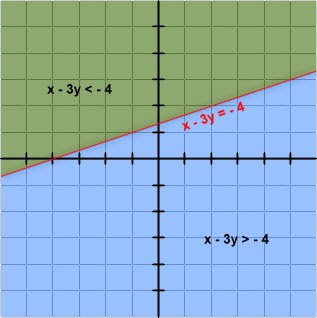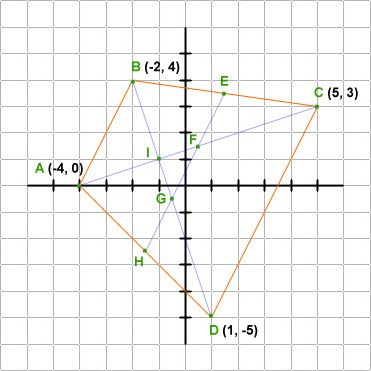Coordinate Graphs of Triangles
The illustrated problems below are graphs of the following triangles:
- isosceles triangles
- scalene triangles
- right triangles
Concepts Illustrated By the Problems
- distance between two points
- angle between two lines
- point of intersection of two straight lines
- equation of a straight line
Description of the Problems
For each problem, the following information are given:
- equations of the line segments
- slopes of the line segments
- x-intercepts and y-intercepts of the lines
- distances between the terminal points of the line segments
- interior angles of the triangles
Using one or a combination of two or more of the above information, it is possible for a problem to be presented in several ways.
Line segments and their terminal points referred to in the problems are the sides and vertices, respectively, of the triangles.
Slope of a line segment with terminal points A and B is abbreviated as mAB.
Distance between points A and B is abbreviated as distanceAB
Graphs of Isosceles Triangles
Show that points A(-5, 1), B(3, 5), C(2, -3) are vertices of an isosceles triangle.
.jpg)
Distance Between Two Points
- distanceAB = √ 80
- distanceBC = distanceAC = √ 65
Equations of the Line Segments
- line segment AB: x - 2y + 7 = 0 (x-intercept = -7; y-intercept = 7/2)
- line segment BC: 8x - y - 19 = 0 (x-intercept = 19/8, y-intercept = -19)
- line segment AC: 4x + 7y + 13 = 0 (x-intercept = - 13/4, y-intercept = - 13/7)
Slopes of the Line Segments
- mAB = 1/2
- mBC = 8
- mAC = - 4/7
Interior Angles of the Triangle
- angle A = angle B = 56.3°
- angle C = 67.4°
Show that points A(-5, 4), B(3, 3), C(-1, -4) are vertices of an isosceles triangle.
.jpg)
Distance Between Two Points
- distanceAB = distanceBC = √ 65
- distanceAC = √ 80
Equations of the Line Segments
- line segment AB: x + 8y - 27 = 0 ( x-intercept = 27, y-intercept = 27/8)
- line segment BC: 7x - 4y - 9 = 0 (x-intercept = 9/7, y-intercept = - 9/4)
- line segment AC: 2x + y + 6 = 0 (x-intercept = -3, y-intercept = -6)
Slopes of the Line Segments
- mAB = - 1/8
- mBC = 7/4
- mAC = -2
Interior Angles of the Triangle
- angle A = angle C = 56.3°
- angle B = 67.4°
Prove analytically that points A(-5, -5), B(-2, 6), C(5, -3) are vertices of an isosceles triangle.
.jpg)
Distance Between Two Points
- distanceAB = distanceBC = √ 130
- distanceAC = √ 104
Equations of the Line Segments
- line segment AB: 11x - 3y + 40 = 0 (x-intercept = - 40/11, y-intercept = 40/3)
- line segment BC: 9x + 7y - 24 = 0 (x-intercept = 24/9, y-intercept = 24/7)
- line segment AC: x - 5y - 20 = 0 (x-intercept = 20, y-intercept = -4)
Slopes of the Line Segments
- mAB = 11/3
- mBC = - 9/7
- mAC = 1/5
Interior Angles of the Triangle
- angle A = angle C = 63.4°
- angle B = 53.1°
Graphs of Scalene Triangles
Show that points A(-4, 1), B(1, 0), C(-2, -5) are vertices of a scalene triangle.
.jpg)
Distance Between Two Points
- distanceAB = √ 26
- distanceBC = √ 34
- distanceAC = √ 40
Equations of the Line Segments
- line segment AB: x + 5y - 1 = 0 (x-intercept = 1, y-intercept = 1/5)
- line segment BC: 5x - 3y - 5 = 0 (x-intercept = 1, y-intercept = - 5/3)
- line segment AC: 3x + y + 11 = 0 (x-intercept = - 11/3, y-intercept = -11)
Slopes of the Line Segments
- mAB = - 1/5
- mBC = 5/3
- mAC = -3
Interior Angles of the Triangle
- angle A = 60.3°
- angle B = 70.3°
- angle C = 49.4°
Show that the following points are vertices of a scalene triangle:
- A (-5, -4)
- B (3, 4)
- C (4, -2)
.jpg)
Distance Between Two Points
- distanceAB = √ 128
- distanceBC = √ 37
- distanceAC = √ 85
Equations of the Line Segments
- line segment AB: x - y + 1 = 0 (x-intercept = -1, y-intercept = 1)
- line segment BC: 6x + y - 22 = 0 (x-intercept = 11/3, y-intercept = 22)
- line segment AC: 2x - 9y - 26 = 0 (x-intercept = 13, y-intercept = - 26/9)
Slopes of the Line Segments
- mAB = 1
- mBC = -6
- mAC = 2/9
Interior Angles of the Triangle
- angle A = 32.5°
- angle B = 54.5°
- angle C = 93.0°
Show that the points A(-3, 5), B(5, -2), C(-1, -5) are vertices of a scalene triangle.
.jpg)
Distance Between Two Points
- distanceAB = √ 113
- distanceBC = √ 45
- distanceAC = √ 104
Equations of the Line Segments
- line segment AB: 7x + 8y - 19 = 0 (x-intercept = 19/7, y-intercept = 19/8)
- line segment BC: x - 2y - 9 = 0 (x-intercept = 9, y-intercept = - 9/2)
- line segment AC: 5x + y + 10 = 0 (x-intercept = -2, y-intercept = -10)
Slopes of the Line Segments
- mAB = - 7/8
- mBC = 1/2
- mAC = -5
Interior Angles of the Triangle
- angle A = 37.5°
- angle B = 67.8°
- angle C = 74.7°
Graphs of Right Triangles
Prove that points A(-1, 5), B(5, -1), C(-4, 2) are vertices of a right triangle.
.jpg)
Distance Between Two Points
- distanceAB = √ 72
- distanceBC = √ 90
- distanceAC = √ 18
Equations of the Line Segments
- line segment AB: x + y - 4 = 0 (x-intercept = 4, y-intercept = 4)
- line segment BC: x + 3y - 2 = 0 (x-intercept = 2, y-intercept = 2/3)
- line segment AC: x - y + 6 = 0 (x-intercept = -6, y-intercept = 6)
Slopes of the Line Segments
- mAB = -1
- mBC = - 1/3
- mAC = 1
Interior Angles of the Triangle
- angle A = 90.0°
- angle B = 26.6°
- angle C = 63.4°
Show that points A(-5, 3), B(2, -1), C(-1, -3) are vertices of a right triangle.
.jpg)
Distance Between Two Points
- distanceAB = √ 65
- distanceBC = √ 13
- distanceAC = √ 52
Equations of the Line Segments
- line segment AB: 4x + 7y - 1 = 0 (x-intercept = 1/4, y-intercept = 1/7)
- line segment BC: 2x - 3y - 7 = 0 (x-intercept = 7/2, y-intercept = - 7/3)
- line segment AC: 3x + 2y + 9 = 0 (x-intercept = -3, y-intercept = - 9/2)
Slopes of the Line Segments
- mAB = - 4/7
- mBC = 2/3
- mAC = - 3/2
Interior Angles of the Triangle
- angle A = 26.6°
- angle B = 63.4°
- angle C = 90.0°
Prove that points A(-2, 5), B(4, -3), C(0, -6) are vertices of a right triangle.
.jpg)
Distance Between Two Points
- distanceAB = √ 100
- distanceBC = √ 25
- distanceAC = √ 125
Equations of the Line Segments
- line segment AB: 4x + 3y - 7 = 0 (x-intercept = 7/4, y-intercept = 7/3)
- line segment BC: 3x - 4y - 24 = 0 (x-intercept = 8, y-intercept = -6)
- line segment AC: 11x + 2y + 12 = 0 (x-intercept = - 12/11, y-intercept = -6)
Slopes of the Line Segments
- mAB = - 4/3
- mBC = 3/4
- mAC = - 11/2
Interior Angles of the Triangle
- angle A = 26.6°
- angle B = 90.0°
- angle C = 63.4°
Graphs of Isosceles Right Triangles
Prove that the points A(-4, 1), B(1, 5), C(0, -4) are vertices of an isosceles right triangle.
.jpg)
Distance Between Two Points
- distanceAB = √ 41
- distanceBC = √ 82
- distanceAC = √ 41
Equations of the Line Segments
- line segment AB: 4x - 5y + 21 = 0 (x-intercept = - 21/4, y-intercept = 21/5)
- line segment BC: 9x - y - 4 = 0 (x-intercept = 4/9, y-intercept = -4)
- line segment AC: 5x + 4y + 16 = 0 (x-intercept = - 16/5, y-intercept = -4)
Slopes of the Line Segments
- mAB = 4/5
- mBC = 9
- mAC = - 5/4
Interior Angles of the Triangle
- angle A = 90°
- angle B = 45°
- angle C = 45°
Show that points A(-5, 4), B(0, 2), C(-2, -3) are vertices of an isosceles right triangle.
.jpg)
Distance Between Two Points
- distanceAB = √ 29
- distanceBC = √ 29
- distanceAC = √ 58
Equations of the Line Segments
- line segment AB: 2x + 5y - 10 = 0 (x-intercept = 5, y-intercept = 2)
- line segment BC: 5x - 2y + 4 = 0 (x-intercept = - 4/5, y-intercept = 2)
- line segment AC: 7x + 3y + 23 = 0 (x-intercept = - 23/7, y-intercept = - 23/3)
Slopes of the Line Segments
- mAB = - 2/5
- mBC = 5/2
- mAC = - 7/3
Interior Angles of the Triangle
- angle A = 45°
- angle B = 90°
- angle C = 45°
Prove that points A(-3, 4), B(5, 1), C(-6, -4) are vertices of an isosceles right triangle.
.jpg)
Distance Between Two Points
- distanceAB = √ 73
- distanceBC = √ 146
- distanceAC = √ 73
Equations of the Line Segments
- line segment AB: 3x + 8y - 23 = 0 (x-intercept = 23/3, y-intercept = 23/8)
- line segment BC: 5x - 11y - 14 = 0 (x-intercept = 14/5, y-intercept = - 14/11)
- line segment AC: 8x - 3y + 36 = 0 (x-intercept = - 9/2, y-intercept = 12)
Slopes of the Line Segments
- mAB = - 3/8
- mBC = 5/11
- mAC = 8/3
Interior Angles of the Triangle
- angle A = 90°
- angle B = 45°
- angle C = 45°











.jpg)
.jpg)
.jpg)
.jpg)
.jpg)
.jpg)
.jpg)
.jpg)
.jpg)
.jpg)
.jpg)
.jpg)
.jpg)
.jpg)
.jpg)
.jpg)
.jpg)
.jpg)
.jpg)
.jpg)
.jpg)
.jpg)
.jpg)
.jpg)
.jpg)
.jpg)

.jpg)
.jpg)
.jpg)
.jpg)
.jpg)
.jpg)
.jpg)
.jpg)
.jpg)
.jpg)
.jpg)
.jpg)